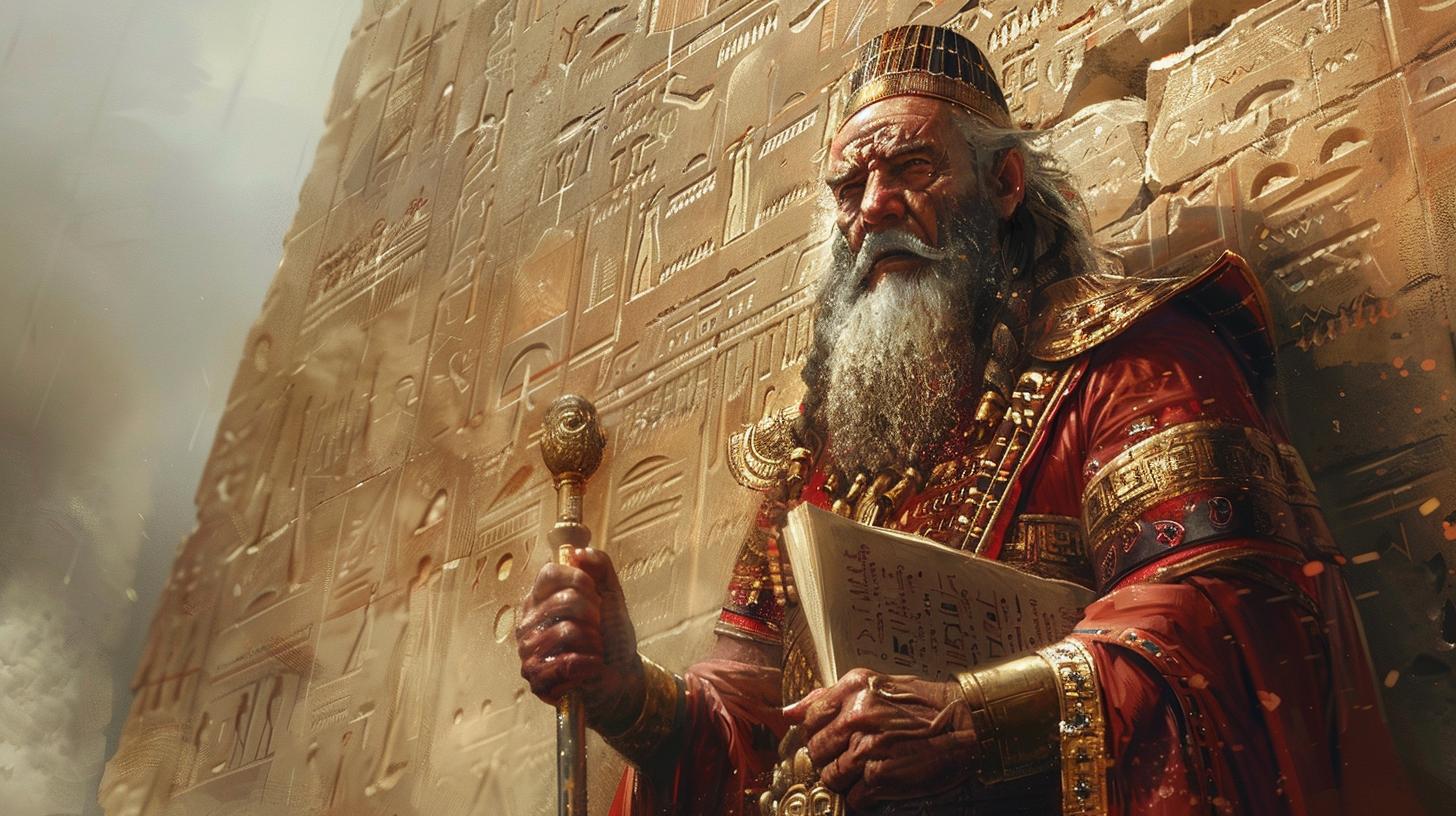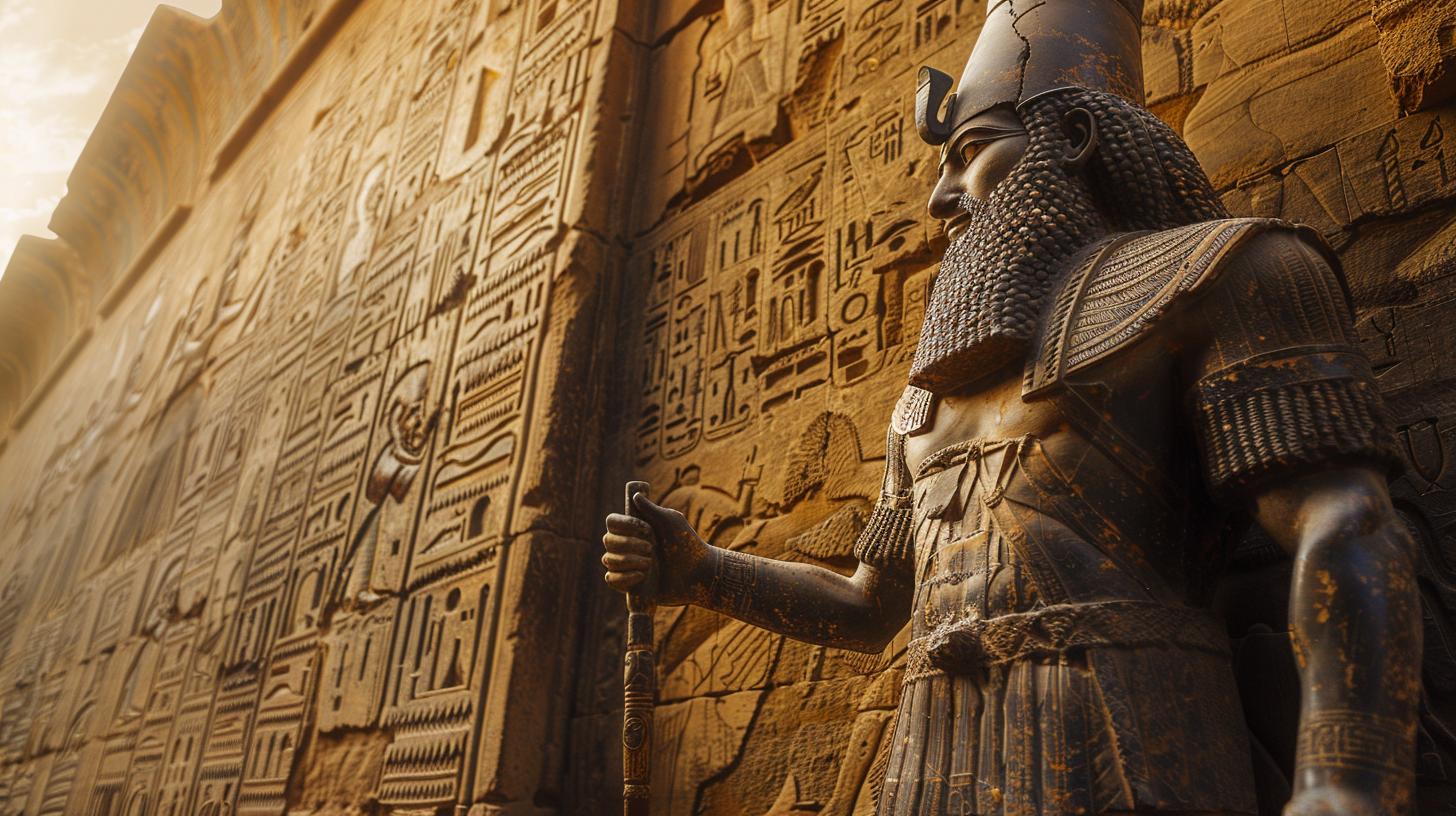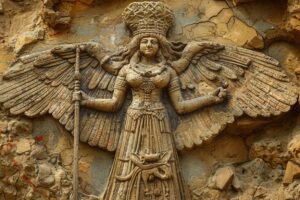Hasamelis God: Unraveling the Ancient Deity’s Role and Influence

Hasamelis, also known as Ḫašamili or Ḫašammili, is a mysterious deity from the Bronze Age in Anatolia. Initially worshiped by the Hattians, he was later incorporated into the Hittite, Palaic, and Luwian pantheons.
Hasamelis is associated with the protection of the household and blacksmithing. He is also linked to martial aspects and various ritual tools. His worship included specific practices and festivals in ancient Anatolia.
The Enigmatic Origins of Hasamelis
The origins of Hasamelis are deeply rooted in the ancient cultures of Anatolia, spanning different periods and regions.
Hattic Roots and Variations of the Name
The name Hasamelis, also referred to as Ḫašamili or Ḫašammili, originates from the Hattic language. This ancient tongue provides several phonetic variations found in cuneiform texts. The different spellings reflect the diverse pronunciations across regions and periods.
In Hattic culture, Hasamelis was considered a deity with multiple roles and characteristics, often associated with protection and craftsmanship. The Hattic texts highlight the complex nature of this god, whose full scope of functions is still subject to scholarly debate.
Transition to Hittite Pantheon
As the Hittites rose to power in Anatolia, they incorporated many deities from the older Hattic pantheon, including Hasamelis. The adaptation into the Hittite belief system marked a significant shift in the perception and worship of Hasamelis.
In the Hittite context, Hasamelis retained some of his original roles but also acquired new attributes. He became known as a protective figure and was linked to domestic wellbeing. The Hittite records, including construction rituals and royal decrees, often mention Hasamelis, indicating his importance in their society.
Presence in Palaic and Luwian Traditions
The influence of Hasamelis extended beyond the Hattic and Hittite cultures to the Palaic and Luwian regions. These traditions, while distinct, shared certain common elements in their religious practices, allowing the integration of deities like Hasamelis.
In Palaic texts, Hasamelis appears in various forms, and like in Hittite traditions, he is associated with protective roles. The Luwians, on the other hand, emphasized different aspects of his character, particularly his connection to craftsmanship and tools, highlighting the regional variations in his worship.
Key Roles and Symbolism
Hasamelis holds various significant roles and symbolism in ancient Anatolian culture.
Protector of the Household
One of the primary roles of Hasamelis was as a protector of the household. He was believed to safeguard families and ensure the well-being of children. Rituals and offerings were commonly made in his name to invoke his protection over homes and loved ones.
This protective aspect extended to warding off evil forces and ensuring domestic harmony.
Associated with Blacksmithing
Hasamelis was closely linked to the craft of blacksmithing. He was regarded as a master blacksmith, embodying the skills and knowledge essential for working with metals. Tools such as bronze hammers and iron nails, frequently mentioned in ancient rituals, symbolize his dominion over this craft.
Thus, blacksmiths often sought his favor to enhance their skills and ensure the quality of their work.
Martials and War Associations
Besides domestic and craft aspects, Hasamelis had connections to martial and war-related roles. Some texts and interpretations suggest he played a role in concealing the Hittite army from enemies, highlighting his strategic and protective capabilities in warfare.
This martial association, while less documented, adds a layer of complexity to his character, blending peace and conflict elements.
Ritual Tools and Objects
The presence of specific tools and objects in rituals dedicated to Hasamelis underscores his importance. These ritual items often included:
- Bronze hammers
- Iron nails
- Other blacksmithing tools
Such tools were not only functional but also symbolic, representing his dual role as a divine craftsman and a protector.
Ritual practices utilized these objects to invoke his blessings and ensure the efficacy of various ceremonies.
The use of these tools in sacred rituals highlights his integral role in ancient religious practices and the multifaceted nature of his worship.
The Cult and Worship Practices
The worship of Hasamelis spanned various regions and periods, reflecting his significance in ancient Anatolian cultures.
Early Assyrian Period and Kanesh
The earliest references to Hasamelis, under the variant name Ḫazamil, appear in texts from the Old Assyrian trading colony at Kanesh. These documents point to an early worship practice, indicating that Hasamelis was already integrated into local religious life before the rise of the Hittite Empire.
The ancient merchants and settlers appealed to Hasamelis for protection and blessings in their household and commercial endeavors.
Temples and Holy Sites in Hattusa
In the Hittite capital of Hattusa, Hasamelis had a dedicated temple reflecting his esteemed status among the pantheon. This site was essential for various religious rituals and offerings. Archaeological records from Hattusa detail the structure and significant artifacts used in the worship practices centered around Hasamelis.
These included tools and objects tied to his blacksmithing aspects.
Festivals and Religious Celebrations
The KI.LAM Festival
Hasamelis played a notable role in the grand KI.LAM festival, one of the key religious events in Hittite religious life. This festival celebrated the gods’ blessings and was a time for communal feasting, sacrifices, and prayers.
Hasamelis’s inclusion in the KI.LAM festival highlights his importance in ensuring household prosperity and protection. Rituals performed during the festival often involved invoking Hasamelis’s favor and using symbols associated with his divine blacksmithing skills.
Mythological Narratives and Associations
Hasamelis appears in various mythological contexts, often intertwined with other gods and figures. These narratives offer a glimpse into his complex and multifaceted role in ancient religions.
Myth of Haḫḫima and Divine Escape
In the myth of Haḫḫima, Hasamelis is depicted as one of the few deities who escape the grasp of Haḫḫima, theorized to be a personification of frost or numbness. His survival is ascribed to a familial connection, as his brothers are considered the brothers of Haḫḫima, leading to mercy on his part.
This narrative highlights the god’s ability to transcend natural calamities and maintain his influence.
The Role of the Gulšeš Goddesses
The Gulšeš Goddesses, often associated with destiny and fate, are frequently mentioned alongside Hasamelis. Their involvement in the same mythological stories underscores a shared realm of influence in divine protection and intervention.
The intertwined roles of Hasamelis and the Gulšeš suggest a combined effort in safeguarding the well-being and destiny of humans.
Relations with Deities of the Moon, Stars, and Night
Hasamelis also holds connections with celestial deities, including those representing the moon, stars, and night. This association is noted in various lists of offerings where these deities appear together, indicating potential ritualistic or symbolic links.
Some scholars propose that these relationships point to a broader narrative context where Hasamelis played a part in the cosmic order and nighttime rituals. The exact nature of these connections remains a topic for further scholarly exploration.
Historical and Cultural Influence
Hasamelis had a significant impact on various cultures and religions throughout history, revealing a complex web of associations and interpretations.
Connections to Other Gods and Cultures
Kasmilos and Greek Religion
Some scholars have suggested that Hasamelis influenced the figure of Kasmilos, also known as Cadmilus, a deity associated with the Kaberoi in Samothrace. Kasmilos is often linked to Hermes in Greek mythology.
The potential connection to Hasamelis indicates cultural exchanges between the Hittite and Greek worlds. Ian Rutherford proposes that this influence might have spread westward from Pala through Wilusa or Assuwa.
The Kaberoi in Samothrace
The Kaberoi, a group of ancient deities worshiped in the Aegean region, particularly in Samothrace, show potential links to Hasamelis. These deities were associated with mystery cults and the protection of sailors.
The link to Hasamelis suggests a shared function of safeguarding, resonating with Hasamelis’s role as a protector.
Interpretations by Scholars
Volkert Haas’s Theories
Volkert Haas explores the multifaceted nature of Hasamelis, emphasizing his role as a protective deity. Haas discusses the god’s associations with the household and blacksmithing, and speculates on his potential connections to lunar and nightly deities.
These interpretations highlight the deity’s protective and apotropaic functions.
Piotr Taracha’s Contributions
Piotr Taracha focuses on the incorporation of Hasamelis into various pantheons and his significance in religious practices. Taracha examines how Hasamelis was celebrated in festivals like KI.LAM and identifies his presence in the Hittite, Palaic, and Luwian traditions, illustrating the god’s cultural integration and importance over time.
Hasamelis in Modern Fiction and Pop Culture
Hasamelis, an ancient deity, has made its way into modern narratives and popular culture, providing a rich source of inspiration for creators.
Representation in Games and Narratives
Hasamelis has found a place in various forms of modern media, especially in the realms of games and storytelling. These new interpretations often blend historical elements with creative liberties to breathe new life into this enigmatic god.
Hasamelis in World Anvil
In the popular world-building platform World Anvil, Hasamelis is depicted as a God Old who was left behind when a critical fragment was stolen and lost. This event turned him to stone by the act of Eleri, a key figure in the narrative.
This version of Hasamelis reveals a more tender side of the deity, as he harbors a deep love for Eleri. However, this affection is unreciprocated, as Eleri’s heart belongs to Yorath, adding a layer of drama and intrigue to the character.
Contemporary Interpretations
Modern takes on Hasamelis often reinterpret his roles and characteristics, situating him within new contexts that resonate with today’s audiences.
These interpretations may explore various facets of Hasamelis, from his skills in blacksmithing to his associations with warfare and protection.
They reflect a blend of ancient mythology and contemporary storytelling techniques, ensuring that the legacy of Hasamelis remains relevant.
- Some narratives emphasize his protective qualities, framing him as a guardian figure.
- Others focus on his craftsmanship, portraying him as a master blacksmith.
- In some modern retellings, Hasamelis’s war associations are highlighted, casting him as a strategic and powerful deity on the battlefield.
Whether through games, literature, or other media, the depiction of Hasamelis continues to evolve, ensuring that this ancient deity remains a vibrant part of modern culture.
Frequently Asked Questions
This section answers common questions about Hasamelis, a complex deity with a rich history and many roles in ancient Anatolian cultures.
What is the origin of Hasamelis?
Hasamelis originated in the Hattic culture of Anatolia. His name, known through variations such as Ḫašamili and Ḫašammili, reflects the linguistic diversity of the ancient texts that mention him. Over time, Hasamelis was incorporated into the Hittite, Palaic, and Luwian religious traditions, indicating his widespread cult.
What roles did Hasamelis play?
Hasamelis served multiple roles in ancient Anatolian religions, each highlighting different aspects of the deity’s character and influence.
Protector of the Household
One of the primary roles of Hasamelis was as a protector of the household. He was believed to safeguard families, particularly children, from harm, ensuring their well-being and safety.
Associated with Blacksmithing
Hasamelis was also closely associated with blacksmithing. He was revered as a ‘strong blacksmith,’ linked to various tools such as bronze hammers and iron nails used in construction rituals and everyday smithing tasks.
Martials and War Associations
Though primarily a domestic and artisan deity, Hasamelis had martial associations. Some scholars suggest his role in hiding the Hittite army from enemies indicates a protective military aspect.
Ritual Tools and Objects
Hasamelis appears in various rituals involving specific tools and objects. These tools, prominently featured in the construction of temples, underscore his significance in religious and practical contexts.
Where was Hasamelis worshipped?
Hasamelis was worshipped in several locations in ancient Anatolia, each contributing to his enduring legacy.
Early Assyrian Period and Kanesh
In the early Assyrian period, Hasamelis, under the name Ḫazamil, was acknowledged in texts from the trading colony of Kanesh. This early mention shows his significance even before widespread Hittite adoption.
Temples and Holy Sites in Hattusa
Hasamelis had a dedicated temple in the Hittite capital, Hattusa. This temple was a significant site where his worship was formalized and maintained.
Festivals and Religious Celebrations
Hasamelis was celebrated during several festivals and religious ceremonies, reflecting his integrated role in the spiritual life of the Hittites.
The KI.LAM Festival
One notable festival where Hasamelis was honored is the KI.LAM Festival, a key event in the religious calendar of Hattusa. This festival underscored his importance among the deities worshipped in the city.
How is Hasamelis represented in modern fiction?
In contemporary times, Hasamelis has found new life in various forms of modern fiction, particularly in narrative games and story platforms.
Representation in Games and Narratives
Hasamelis appears in games like those on the World Anvil platform, where his mythology is reimagined for current audiences. These representations bring ancient legends into modern contexts, adding layers to his mythos.
Hasamelis in World Anvil
In World Anvil, Hasamelis is depicted as a God Old, with narratives involving betrayal, transformation, and unrequited love. These stories enrich his character and introduce him to new generations.
Contemporary Interpretations
Modern depictions of Hasamelis vary, each contributing to a broader understanding of his complex identity. These interpretations ensure that the legacy of Hasamelis continues to evolve and inspire.





















